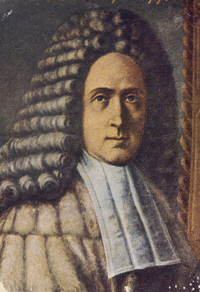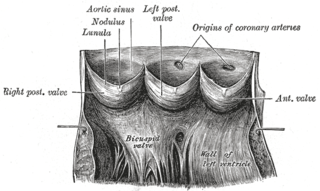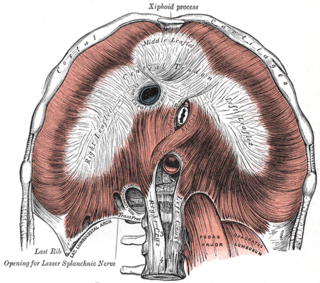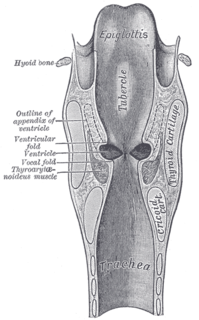Sinus of Morgagni may refer to:
| This disambiguation page lists articles associated with the title Sinus of Morgagni. If an internal link led you here, you may wish to change the link to point directly to the intended article. |
Sinus of Morgagni may refer to:
| This disambiguation page lists articles associated with the title Sinus of Morgagni. If an internal link led you here, you may wish to change the link to point directly to the intended article. |

Paranasal sinuses are a group of four paired air-filled spaces that surround the nasal cavity. The maxillary sinuses are located under the eyes; the frontal sinuses are above the eyes; the ethmoidal sinuses are between the eyes and the sphenoidal sinuses are behind the eyes. The sinuses are named for the facial bones in which they are located.

A lymph node or lymph gland is an ovoid or kidney-shaped organ of the lymphatic system, and of the adaptive immune system, that is widely present throughout the body. They are linked by the lymphatic vessels as a part of the circulatory system. Lymph nodes are major sites of B and T lymphocytes, and other white blood cells. Lymph nodes are important for the proper functioning of the immune system, acting as filters for foreign particles and cancer cells. Lymph nodes do not have a detoxification function, which is primarily dealt with by the liver and kidneys.

Giovanni Battista Morgagni was an Italian anatomist, generally regarded as the father of modern anatomical pathology, who taught thousands of medical students from many countries during his 56 years as Professor of Anatomy at the University of Padua.

An aortic sinus is one of the anatomic dilations of the ascending aorta, which occurs just above the aortic valve. These widenings are between the wall of the aorta and each of the three cusps of the aortic valve.

Antonio Maria Valsalva, was an Italian anatomist born in Imola. His research focused on the anatomy of the ears. He coined the term Eustachian tube and he described the aortic sinuses of Valsalva in his writings, published posthumously in 1740. His name is associated with the Valsalva antrum of the ear and the Valsalva maneuver, which is used as a test of circulatory function. Anatomical structures bearing his name are Valsalva’s muscle and taeniae Valsalvae.
The development of the urinary system begins as a part of prenatal development, and relates to the development of both the urinary system and the sex organs. It continues as a part of sexual differentiation.

The superior pharyngeal constrictor muscle is a muscle in the pharynx. It is the highest located muscle of the three pharyngeal constrictors. The muscle is a quadrilateral muscle, thinner and paler than the inferior pharyngeal constrictor muscle and middle pharyngeal constrictor muscle.

The sternocostal triangle or foramina of Morgagni are small zones lying between the costal and sternal attachments of the thoracic diaphragm. Important vessels that pass through these bilateral foramina include the superior epigastric arteries as terminations of the internal thoracic arteries, with accompanying veins and lymphatics.
Stokes–Adams syndrome is a periodic fainting spell in which there is a periodic onset and offset of blockage of heart due to disorder of heart rhythm that may last for seconds, hours, days, or even weeks before the conduction returns. Named after two Irish physicians, Robert Adams (1791–1875) and William Stokes (1804–1877), the first description of the syndrome was published in 1717 by the Carniolan physician of Slovene descent Marko Gerbec, which was 44 years after its publication quoted by Giovanni Battista Morgagni. It is characterised by decrease in cardiac output and loss of consciousness due to a transient arrhythmia. For example, bradycardia due to complete heart block.
Morgagni can refer to:

Anal columns are a number of vertical folds, produced by an infolding of the mucous membrane and some of the muscular tissue in the upper half of the lumen of the anal canal. They are named after Giovanni Battista Morgagni who also has several other eponyms named after himself.

Vesicular appendages of the epoöophoron are small pedunculated vesicles of the fimbriae of the uterine tube, or connected to the broad ligament. They were described by Giovanni Battista Morgagni and are remnants of the cranial part of the mesonephric duct. Typically they are asymptomatic.

The laryngeal ventricle, is a fusiform fossa, situated between the vestibular and vocal folds on either side, and extending nearly their entire length. There is also a sinus of Morgagni in the pharynx.

Laryngocele refers to a congenital anomalous air sac communicating with the cavity of the larynx, which may bulge outward on the neck.
Lacunae of Morgagni, also called the urethral lacunae of the male urethra, are small depressions or recesses on the surface of the mucous membrane of the urethra. Their openings are usually directed distally. The largest of these recesses is called lacuna magna, which is situated on the upper surface of the fossa navicularis.
The development of the reproductive system is a part of prenatal development, and concerns the sex organs. It is a part of the stages of sexual differentiation. Because its location, to a large extent, overlaps the urinary system, the development of them can also be described together as the development of the urinary and reproductive organs.

Domenico Piemontesi was an Italian professional road bicycle racer. He is most known for his 12 stage wins in the Giro d'Italia and a bronze medal at the 1927 World Championships.

Morgagni-Stewart-Morel syndrome is a condition with a wide range of associated endocrine problems including: diabetes mellitus, diabetes insipidus, and hyperparathyroidism. Other signs and symptoms include headaches, vertigo, hirsutism, menstrual problems, galactorrhoea, obesity, depression, and seizures. Thickening of the inner table of the frontal part of the skull a usually benign condition known as hyperostosis frontalis interna. The syndrome was first described in 1765. It is named after the Italian anatomist and pathologist Giovanni Battista Morgagni, the British neurologist Roy Mackenzie Stewart, and the Swiss psychiatrist Ferdinand Morel.
In the pharynx, the sinus of Morgagni is the enclosed space between the upper border of the superior pharyngeal constrictor muscle, the base of the skull and the pharyngeal aponeurosis.